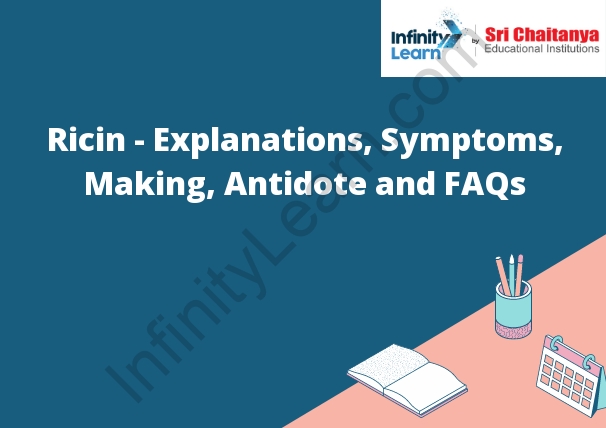Table of Contents
Ricin – Explanations, Symptoms, Making, Antidote and FAQs
Ricin is a toxin made from the castor oil plant that can cause severe illness. It is a poison that can be inhaled, ingested, or injected. Ricin can be made from the waste material left over from processing castor beans.
People exposed to ricin may experience fever, chest pain, shortness of breath, coughing, nausea, and vomiting. Ricin can also cause fluid to build up in the lungs, which can lead to respiratory failure. If ricin is ingested, it can cause severe stomach pain, bloody diarrhea, and vomiting. If ricin is injected, it can cause severe pain at the injection site, as well as swelling and redness.
There is no specific antidote for ricin poisoning. Treatment focuses on supporting the patient’s breathing and other vital functions.

What is Ricin?
Ricin is a toxin made from the castor bean plant. It is a poison that can be inhaled, ingested, or injected. Ricin can cause respiratory failure, kidney failure, and death.
What are The Symptoms of Ricin Poisoning?
The symptoms of ricin poisoning depend on how the person was exposed to the poison. ricin can be inhaled, ingested, or injected.
Inhalation: Symptoms of ricin inhalation poisoning include difficulty breathing, chest pain, and coughing.
Ingestion: Symptoms of ricin ingestion poisoning include vomiting, diarrhea, and stomach pain.
Injection: Symptoms of ricin injection poisoning include muscle weakness, drooping eyelids, and respiratory failure.
How to Make Ricin?
Ricin is a highly toxic protein found in castor beans. It can be made into a powder, mist, or pellet, and it is lethal in doses as small as a few grains. Ricin is easy to make, and it is most likely that someone with terrorist ties will be the one to produce it. In this essay, I will discuss the methods for making ricin, and I will provide steps that can be taken to prevent its production.
There are three main methods for making ricin: the wet method, the dry method, and the acid method. The wet method is the most common, and it involves the use of a blender or food processor to grind the beans into a paste. The paste is then mixed with water, and the ricin is extracted from the solution. The dry method involves roasting the beans, then grinding them into a powder. The powder is then mixed with a solvent, such as ethanol or acetone, and the ricin is extracted. The acid method is the most dangerous, and it involves the use of hydrochloric acid to extract the ricin from the beans.
There are several steps that can be taken to prevent the production of ricin. First, the castor beans should be kept in a secure location, and they should be inaccessible to the general public. Second, the wet and dry methods for making ricin should be strictly prohibited. Finally, the acid method for making ricin should be closely monitored, and it should only be used by individuals who are properly trained in its use.
What is The Ricin Toxin?
Ricin toxin is a protein produced by the bacterium Ricinus communis. The toxin is an extremely potent poison, and is one of the most poisonous naturally occurring substances. It is a lectin, a type of protein that binds to sugar molecules. Ricin toxin is especially dangerous because it is easily absorbed through the skin and can be fatal even in very small doses.
What is a Ricin Antidote?
A ricin antidote is a medication or other substance that is given to a person who has been poisoned with ricin. The antidote may help to lessen the effects of the poison, or it may help to remove ricin from the person’s body.









